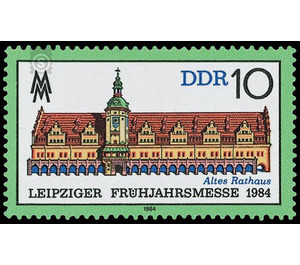Commemorative stamp series - Germany / German Democratic Republic 1984 - 10 Pfennig
Theme: Calender
| Country | Germany / German Democratic Republic |
| Issue Date | 1984 |
| Face Value | 10.00 |
| Color | multi-colored green |
| Perforation | K 14 |
| Printing Type | Rotogravure 2 |
| Stamp Type | Postage stamp |
| Item Type | Stamp |
| Chronological Issue Number | 2604 |
| Chronological Chapter | GER-DDR |
| SID | 846456 |
| In 33 Wishlists | |
Leipziger Spring Fair 1984 At the Leipzig Spring Fair 1984, the Ministry of Posts and Telecommunications of the German Democratic Republic issued two multicolored special postage stamps. Special cancellation from 6 March to 5 May 1984 10 Pfennig value: The Old Town Hall in Leipzig In the middle of the trade fair city, on the historic market, lies the Old Town Hall. It was built by Hieronymus Lotter in 1556 as one of the first renaissance town halls in Germany. In the building is in a characteristic way Gothic heritage with the Baugesinnung, which flowed from the Italian Renaissance in the 16th century to Germany, united. Among the clearest peculiarities of the structure include the latitude and the asymmetry, which determine the overall impression. The roof region is interrupted vertically by six transverse gables called "Zwerchhäuser". This verticalism is further emphasized by the staircase tower emerging from the side of the façade. The interior of the town hall was 1557. On the ground floor there were vaults, the prestigious first floor served the city administration and the judiciary. In 1564 the altan was added to the tower and in 1599 a wind outlet was created. The tower received its current baroque form in 1744. After the construction of the New Town Hall in 1905, the building underwent a major refurbishment from 1906 to 1909 and was subsequently set up as a city-historical museum. On December 4, 1943, the Old Town Hall was severely damaged by Anglo-American bombers; Tower and attic burned out, valuable art treasures fell victim to the flames. After 1945, it was rebuilt as the city's first historic building. Year after year, well over 100,000 visitors familiarize themselves with the history of the city and experience impressive events and concerts in the festival hall, in the historic council chamber and in the Mendelssohn room.


